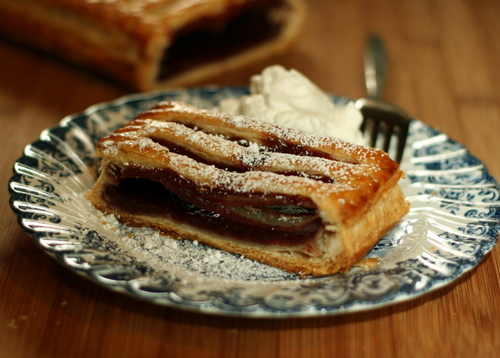 I‘ve always operated under the assumption that real people don’t make puff pastry. Since most recipes that call for it for include “frozen puff pastry, thawed,” on their ingredient lists, I just figured that the secret to all those crazy layers required too much magic for the likes of me to discover.
I‘ve always operated under the assumption that real people don’t make puff pastry. Since most recipes that call for it for include “frozen puff pastry, thawed,” on their ingredient lists, I just figured that the secret to all those crazy layers required too much magic for the likes of me to discover.
But the other day I stumbled across a recipe for puff pastry as I browsed a tapas cookbook. The directions looked simple and not much more complicated than the steps involved in making pie crust. Unable to resist, I measured the flours, salt, and butter and tucked them into the freezer to chill for an hour as directed by the recipe. In the intervening hour I ate my breakfast, took a shower, and started some laundry. Finally I got to mix up my dough and try out the fold and roll technique that would transform six basic ingredients into light, flaky layers of pastry. Within hours of finding the recipe, I wrapped puff pastry around dates stuffed with Parmesan cheese and bacon.
I would love to devote a day of my life to bringing a batch of puff pastry into the world, but until I become a person of leisure or a professional pastry chef, I’m sticking with Joanne Weir’s version–pasta de hojaldre–which did not make it into Mastering the Art of French Cooking, surely only because it represents a Spanish variant of the genre.
If you love to bake from scratch and have felt bullied by presumptuous recipes assuming your incapacity for the art, or at least the craft, of puff pastry, I recommend that you give it a try. You’ll feel like a genius. Seriously.
Since I’ve never made either of Julia’s versions, I can’t offer you a comparison, but I can tell you that my family devoured the entire jam tart I baked with this simple puff pastry in one sitting, after which my daughter asked if I would please make it again the next day.
The stuff puffs shockingly, shatters at the merest touch, and delights to no end. With an active time of maybe 15 to 20 minutes, plus an hour on either end of that, you can have homemade puff pastry ready to use in just over 2 hours. Take that, Julia.
Quick Puff Pastry (AKA Pasta de Hojaldre)
Adapted from From Tapas to Meze, Small Plates from the Mediterranean, by Joanne Weir. Makes approximately 1 pound.
1 cup all-purpose flour
1/2 cup cake flour
1/4 teaspoon salt
16 tablespoons butter (2 sticks), cut into 1/2-inch pieces
2 teaspoons lemon juice
1/4 to 1/3 cup ice water
Mix the flours and salt together in a small bowl and place it in the freezer for 1 hour. Slice butter and place it in the freezer for 1 hour as well.
Place the cold flour mixture in a food processor. Add two pieces of butter and pulse until the butter is finely chopped. Add remaining butter and pulse until the butter is in 1/4-inch pieces. Combine lemon juice and ice water and add most of the water mixture through the feed tube while the processor is running. Stop and pinch some of the dough together between your fingers. If it doesn’t stick, add more water, taking care not to over mix (switch to tossing with a fork if the chunks of butter start getting small).
Turn the dough out onto a large piece of plastic wrap. It will be very crumbly. Using the plastic wrap, shape the mass into a rough rectangle. There will be large chunks of butter showing, and it will look rough and crumbly, but should stick together in a solid mass. Do not knead.
Unwrap the dough and place it on a lightly floured surface. Roll the dough into a 1/2-inch thick rectangle approximately 8 by 10 inches. It will probably crack. Don’t worry. This is good.
Fold the two narrow ends to meet in the center. The dough will crack and break along the folds. Again, don’t worry; press it gently together as best as you can, trying not to overwork it.
Fold the dough in half again so that there are four layers.
Turn the dough one quarter turn. This is your first turn. Roll the dough out again to 1/2-inch thickness and fold as before. Repeat exactly this same way twice more. The dough will crack less as you continue. Finally, roll the dough once again into a 1/2-inch thick rectangle. This time, fold the dough into thirds as you would a business letter.
Wrap the dough in plastic wrap and refrigerate for at least 1 hour or up to 3 days.
Peekaboo Jam Tart (AKA Jalousie)
Adapted from Mastering the Art of French Cooking, Volume Two, by Julia Child. Makes 1 6-by-16-inch tart.
1 recipe quick puff pastry
1 cup or so of strawberry, raspberry, or blackberry jam
1 egg, beaten with 1 teaspoon water
Divide pastry in half and return one portion to the refrigerator. Roll remaining half into an 8-by-18-inch rectangle about 1/8 inch thick. Transfer topside down onto a parchment-lined, uninsulated baking sheet. Prick all over at 1/8-inch intervals with the tines of a fork, going right down through to the parchment paper.
Spread a 1/4-inch layer of jam over the pastry, leaving a 3/4-inch border of pastry all the way around.
Turn the borders of pastry up and over filling at sides; moisten corners with cold water and turn ends over, sealing corners gently with your fingers.
Roll out second piece of pastry into a 7-by-17 inch rectangle (slightly larger than the shaped of filled pastry), 1/8 inch thick. Flour surface lightly; fold in half lengthwise. Measure opening of filled pastry and mark folded pastry to guide you. Cut slits down the folded edge, making them 3/8 inch apart and half as long as the width of the opening in the tart.
Moisten the edges of the filled bottom layer of pastry with cold water. Unfold the top layer of pastry over it; brush off accumulated flour, and press in place with your fingers.
With the back tines of a fork, press a decorative vertical border all around the sides. Cover and chill for at least 30 minutes or until baking time.
Preheat oven to 450° F, placing rack in the lower-middle level. Paint surface of chilled pastry with egg glaze. If the jam is oozing through the openings, take care not to mix it in with the egg glaze too much or the surface will burn. After finishing the first coat, wait a moment, and give it a second coat.
With a sharp knife, make shallow cross-hatchings on top of sides and ends through the glaze, and then set the pastry in the oven. In about 20 minutes, when pastry has risen and is browning nicely, turn heat down to 400° F. Bake 30 to 40 minutes more, covering loosely with foil if the surface is browning too much.
It may seem done before it actually is; sides should be firm and crusty. You want to make sure you dry out and crisp all the inner layers of the pastry. Slide onto a rack when done. Serve warm or at room temperature with crème fraîche or whipped cream.
Some of the links in this post are affiliate links. If you click through and make a purchase, I earn a small commission for my referral at no additional cost to you. Thank you for supporting Flour Arrangements.







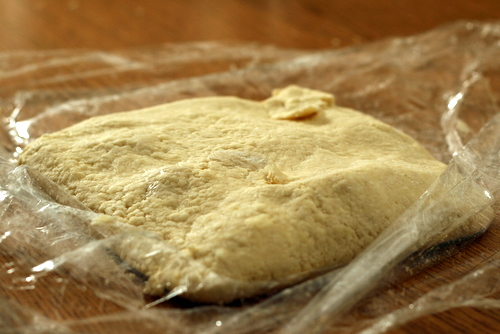

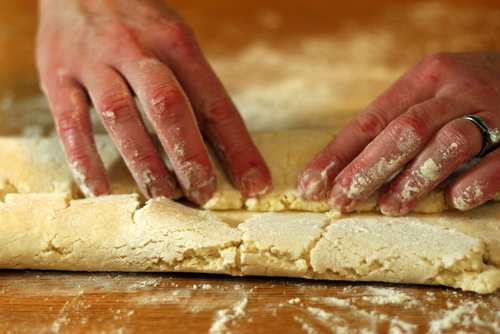
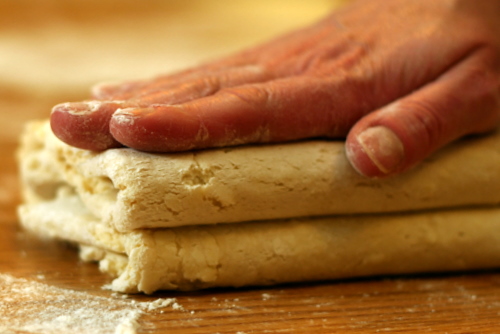
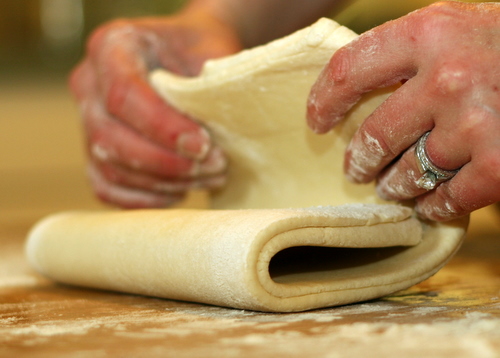
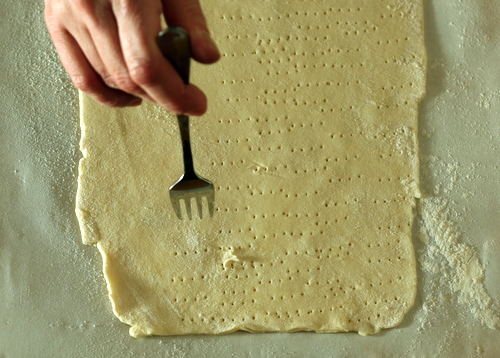
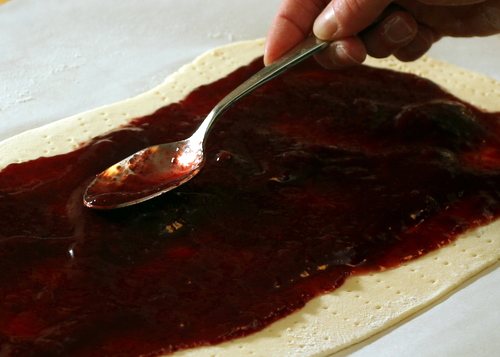
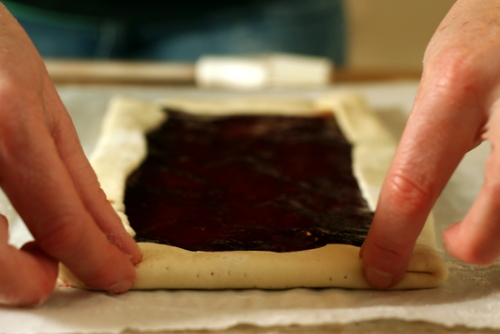
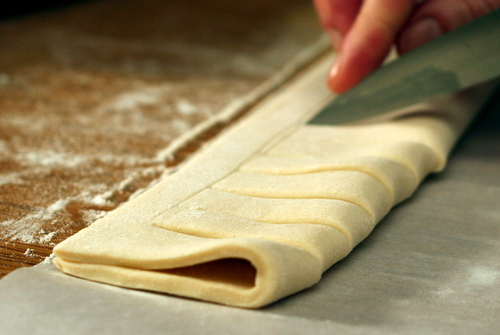
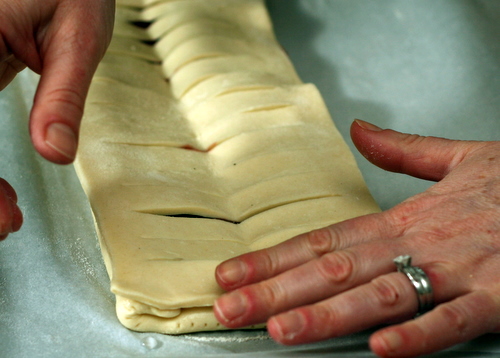
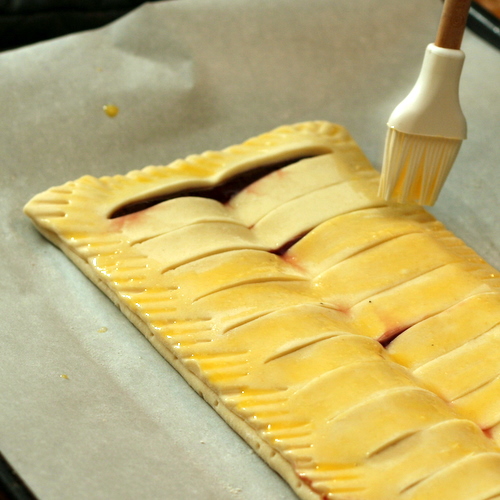
Leave a Reply